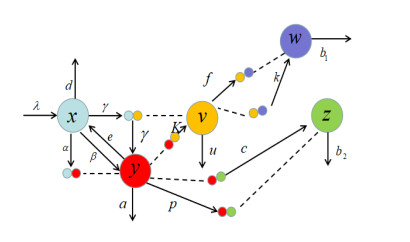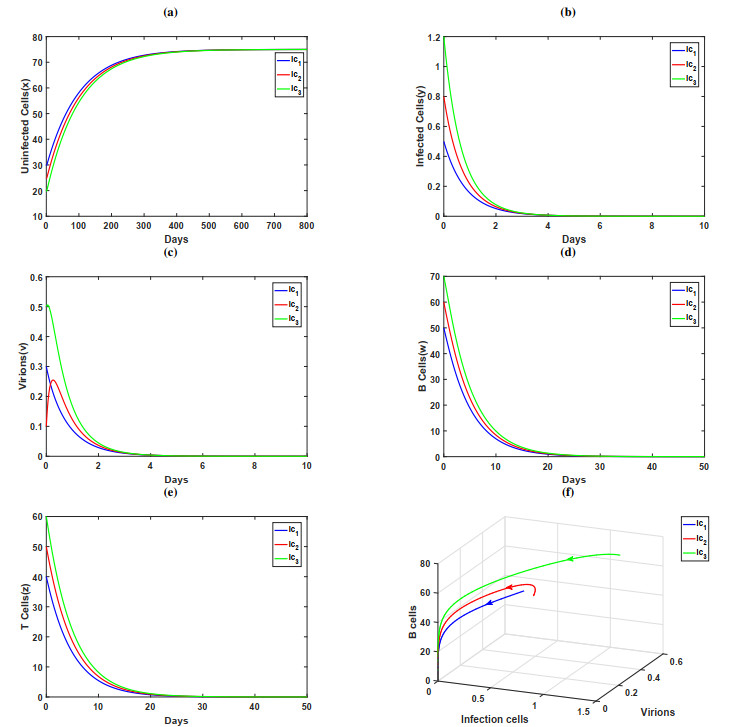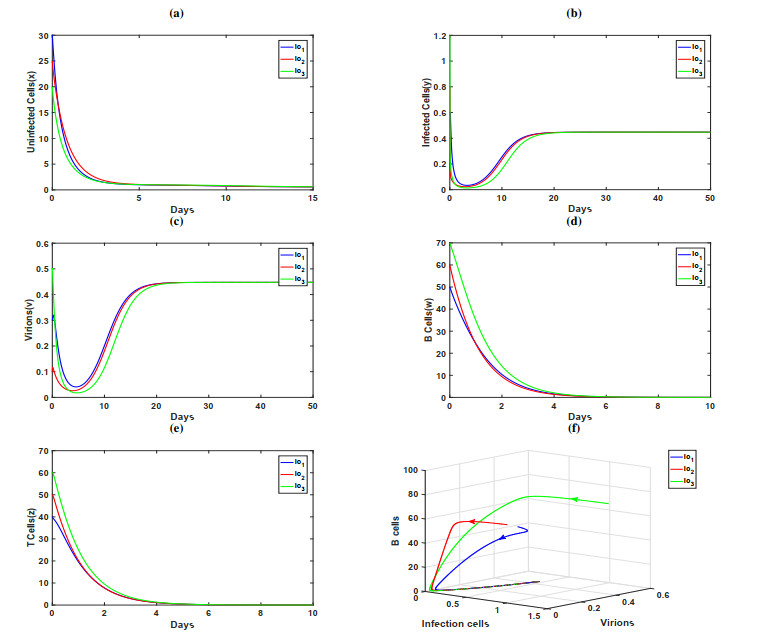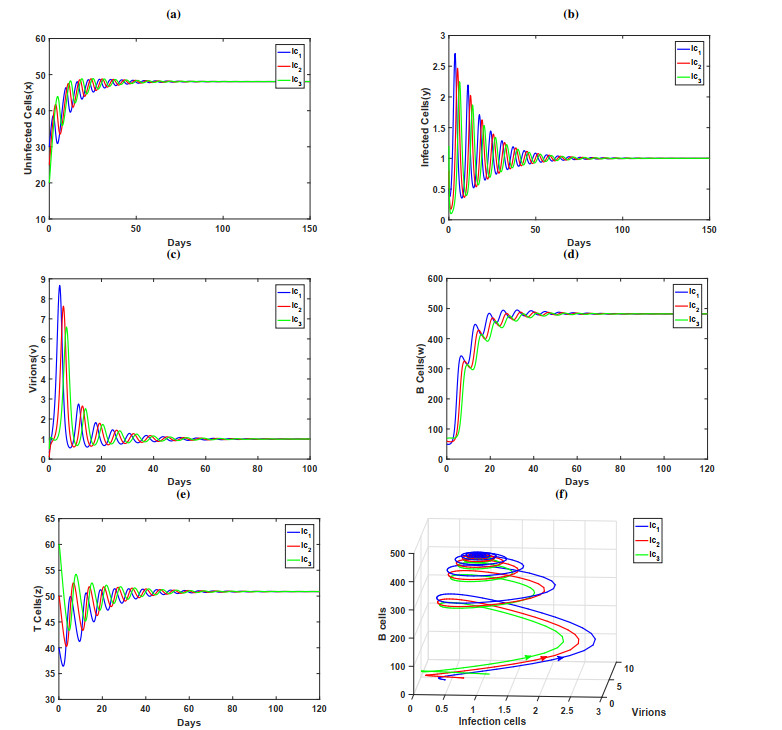1.
Introduction
Fractional calculus (FC) has long been devoted to studying integrals and derivatives of non-integer order. In recent years, researchers have been growing interest in finding the most suitable fractional derivative (FD) for modeling real-world problems. While classical calculus equations are sometimes inadequate for capturing complex systems, fractional calculus methods have proven to be highly effective in modeling phenomena observed in various disciplines such as physics, chemistry, electricity, and mechanics, thanks to their ability to handle long-memory processes [1,2,3,4,5,6,7,8].
Traditionally, the focus of FC was primarily on Riemann-Liouville (RL) and Caputo fractional derivatives. However, as we entered the new millennium, researchers began introducing new types of fractional operators (FO), expanding the field of fractional calculus [9,10,11,12,13,14,15]. It is noteworthy that the FOs proposed in this work are distinct instances of fractional derivatives/integrals compared to those described in [16,17,18]. Nevertheless, they share one crucial characteristic with other FOs, which is nonlocality.
In [19], the authors introduced a local FD, known as the conformable derivative (CD). The conceptualization of these local FD eventually led to the rediscovery of nonlocal FD previously described in [14]. We provide an overview of the fundamental principles behind the CD and propose a derivative consistent with both the left and right versions. Furthermore, we find that the nonlocal FD version proposed in [20,21] can be derived from [13].
In any form of FC or calculus with derivatives, it is essential for a function's order zero to be equal to the function itself. However, the CD lacks this crucial property, which can be seen as a deficiency. To address this, the authors in [22,23] redefined the CD to ensure that it yields the function itself when the local FD has an order of zero. Subsequently, Sadek [24] introduced the FD version of this redefined CD called cotangent fractional derivative which features the that they achieve a semi-group property, the kernel operator is the exponential of the cotangent function, and is a generalization of the Riemann-Liouville FD and Caputo FD.
The existence and uniqueness of solutions represent significant qualitative properties of fractional differential problems. Several mathematicians have addressed the existence and uniqueness of solutions for fractional differential problems involving various types of FD and boundary/initial conditions (see [25,26,27,28,29,30,31,32,33,34,35]).
From the works of [36,37], we introduce an innovative FD called the Hilfer cotangent fractional derivative. Building upon this newly defined derivative, we investigate the solutions' existence and uniqueness for a distinct class of nonlinear fractional differential problems that feature nonlocal initial conditions. The Hilfer cotangent fractional differential equation is formulated as follows:
In this equation, DG,q,rc+(⋅) represents the Hilfer cotangent fractional derivative (HCFD), and I1−σ,rc+(⋅) denotes the cotangent fractional integral (CFI) with an order of 1−σ>0. Here, ci belongs to the set of real numbers, f:L×R→R is a continuous function, and τi are elements of the interval L satisfying c<τ1<⋯<τm<d, i=1,…,m. The Hilfer fractional model, along with other fractional calculus models, provides a powerful mathematical framework for describing and understanding complex systems and processes that do not conform to traditional integer-order calculus. Its applications are diverse and span various scientific and engineering disciplines. Notably, the existence and uniqueness of solutions for Eq (1.1) have not been previously discussed using this new fractional definition.
The Hilfer fractional model, named after the mathematician Rudolf Gorenflo Hilfer, is a mathematical framework used to describe systems and processes that exhibit non-integer order fractional behavior. Unlike traditional integer-order calculus, fractional calculus, including the Hilfer fractional model, deals with derivatives and integrals of non-integer orders, which allows it to capture more complex dynamics in various domains. Here are some applications of the Hilfer fractional model:
● Anomalous diffusion: The Hilfer fractional model is often used to describe anomalous diffusion, where particles or information spread in a non-standard way. This can be applied to fields like physics (e.g., diffusion in porous media), biology (e.g., cell migration), and finance (e.g., modeling price movements in financial markets).
● Viscoelasticity: The Hilfer fractional model is used to describe the behavior of viscoelastic materials, which exhibit both viscous (liquid-like) and elastic (solid-like) properties. This is relevant in materials science and engineering, especially for modeling polymers and complex fluids.
● Fractional differential equations (FDEs): FDEs based on the Hilfer fractional model are used to describe a wide range of dynamic systems, such as electrical circuits, mechanical systems, and chemical reactions. These equations can capture non-standard responses and memory effects in these systems.
● Control systems: The Hilfer fractional model has applications in control theory for describing and controlling complex systems with fractional dynamics. It's used in areas like robotics, automation, and mechatronics to design controllers for systems with non-integer order behavior.
● Signal processing: Fractional calculus, including the Hilfer fractional model, is applied to signal processing for tasks like noise reduction, image processing, and data compression, where it can capture long-range dependencies in signals.
● Biomedical engineering: The Hilfer fractional model is used in modeling biological and physiological systems, such as modeling drug delivery in the human body or describing the dynamics of neurons in the brain.
● Geophysics: In geophysics, the Hilfer fractional model can be applied to model seismic phenomena, groundwater flow, and other geological processes that exhibit complex, non-integer order behavior.
● Environmental science: Environmental processes that exhibit anomalous behavior, such as pollutant transport in groundwater, can be described using the Hilfer fractional model.
● Economics: Fractional calculus models, including the Hilfer fractional model, have been applied to financial time series analysis and modeling to capture long-term dependencies and improve predictions in financial markets.
● Renewable energy: The modeling of energy storage systems, battery behavior, and renewable energy generation can benefit from the Hilfer fractional model to account for the complex and non-standard behavior of these systems.
The remainder of the manuscript is structured as follows. In Section 2, we provide a review of essential definitions and theoretical results necessary for our subsequent analysis. In Section 3, we introduce our proposed derivatives, namely the Hilfer cotangent fractional derivatives, along with their preliminary properties. Additionally, we explore the connection between an initial value problem and a cotangent Volterra integral equation, establishing uniqueness and the existence of the solution using Banach's fixed point theorem and Kransnoselskii's fixed point theorem. Furthermore, we present two examples to illustrate our findings. Finally, we conclude the paper in Section 4.
2.
Preliminaries of cotangent fractional derivative
In this section, we present preliminary information, definitions, and results related to cotangent fractional derivative, which is fundamental for the rest of the paper. Let us consider finite and infinite intervals −∞<c<d<∞ within the real numbers R+. We denote the space of continuous functions x defined on [c,d] as C[c,d]. The norm for this space is defined as in [4]:
Additionally, we define ACn[c,d], the space of functions x that are n times absolutely continuous differentiable, as:
The weighted space Cσ[c,d] for functions f on (c,d] is defined as:
where the corresponding norm:
Similarly, the weighted space Cnσ[c,d] for functions x on (c,d] is defined as:
where the corresponding norm:
It is worth noting that C0σ[c,d]=Cσ[c,d] when n=0.
Definition 2.1. [4] Suppose that x∈L1([c,d],R). Then the RL integral of order G>0 of the function x is defined by
with Γ(⋅) is the gamma function.
Definition 2.2. [4] Let x∈C([c,d]). The RL fractional derivative of order G such that n−1<G<n,n∈N of the function x is defined by
Definition 2.3. [4] Let x∈Cn([c,d]) and p>0 such that n−1<G<n,n∈N. Then the Caputo fractional derivative of order G of the function x is defined by
where xn(μ)=dnx(μ)dμn.
Definition 2.4. [24] Let G∈C,Re(G)>0 and r∈(0,1]. The CFI of order G of the function x is defined by
Remark 2.5. [24] Let
and
Definition 2.6. [24] The left cotangent fractional derivative of order G∈C (Re(G)>0) and r∈(0,1] of a function x is defined by
where n=[G]+1.
Definition 2.7. [24] Let r∈(0,1]. Then the left-sided cotangent fractional derivative in the sense of Caputo of order G of the function x is defined by
where n=[G]+1.
Remark 2.8. For r=1, Definitions 2.4–2.7 coincide the Definitions 2.1–2.3, respectively.
The cotangent fractional derivative and integral exhibit the following significant properties:
Proposition 2.9. [24] Let r∈(0,1] and δ,G∈C such that Re(δ)>0 and Re(G)≥0. Then we have
Theorem 2.10. [24] Let r∈(0,1],Re(G)>0, Re(q)>0 and x∈C([c,d],R), then we have
Theorem 2.11. [24] Let x∈L1([c,d]). Suppose that r∈(0,1] and 0≤m<[Re(G)]+1. Then
Corollary 2.12. [24] Let 0<Re(q)<Re(G) and m−1<Re(q)≤m. Then we get
Theorem 2.13. [24] Let x∈L1([c,d]),Re(G)>0, n=[Re(G)]+1 and r∈(0,1]. Then
Lemma 2.14. [24] Let m∈Z+, G>0 and r∈(0,1]. Then
In particular, if m=1, we get
Theorem 2.15. [24] Let x∈L1(c,d) and (IG,rc+x)(ℓ)∈ACn[c,d], Re(G)>0,n=−[−Re(G)]. Then
3.
Main results
In this section, we present the HCFD and explore its properties. Furthermore, we establish the equivalence between the given problem (1.1) and a cotangent fractional integral equation of Volterra type. By utilizing fixed point theorems, we then demonstrate the existence and uniqueness of solutions for Eq (1.1).
Definition 3.1. Let n∈N such that n−1<G<n,r∈(0,1] and 0≤q≤1. The left/right HCFD of order G and type q of a function x is defined by
where I is the CFI defined in Eq (2.1).
In particular, if n=1, Eq (3.1) is equivalent with
Thus, throughout this work, we discuss the case where 0<G<1,n=1,0≤q≤1 and σ=G+q−Gq.
This definition can be used in many ways, including: A robust scheme for variable-order time-fractional diffusion-type equations [38], a fractal-fractional-order modified predator-prey mathematical model with immigrations [39], a pseudo-operational collocation method for variable-order time-space fractional KdV-Burgers-Kuramoto equation [40], Leffler-Galerkin method to solve Riccati differential equation of fractional order [41], stability of fractional linear systems [42], and controllability, observability of fractional linear systems [43].
Remark 3.2. It is important to mention that:
(1) If q=0, we get Definition 2.6.
(2) If q=1, we get Definition 2.7.
(3) The parameter σ satisfies
Proposition 3.3. We have
Proof. From Eq (3.2) and Definition 2.6, we get
□
Let us examine the weighted function spaces defined on (c,d] as follows:
and
since
Lemma 3.4. Suppose r∈(0,1],0<G<1, 0≤σ<1 and x∈Cσ[c,d], then
Proof. If we consider x∈C[c,d], it indicates that x belongs to Cσ[c,d] and (ℓ−c)σ belongs to C[c,d]. Consequently, there exists a positive constant M such that
and
It follows from Proposition 2.9, that
this implies that as ℓ approaches to a from the right, the right-hand side tends to zero. □
Lemma 3.5. Let 0<G<1,0≤q≤1,r∈(0,1], σ=G+q−Gq and x∈Cσ1−σ[c,d], then
and
Proof. By utilizing Theorem 2.10 and Proposition 3.3, we can proceed to
Moreover, considering Theorem 2.10 and Eq (3.2), it is evident that
□
Lemma 3.6. Suppose x∈L1(c,d) such that Dq(1−G),pc+x exists in L1(c,d). Then
Proof. By utilizing Definition 2.6 and Eq (3.2), we can deduce that
□
Lemma 3.7. Let 0<G<1 and 0≤σ<1, r∈(0,1]. Let x∈Cσ[c,d] and I1−p,rc+x∈C1σ[c,d], then
for all ℓ∈(c,d].
Proof. The proof follows a similar approach to the ones presented in [24]. □
Lemma 3.8. Let 0<G<1,r∈(0,1],0≤q≤1 and σ=G+q−Gq. Let x∈C1−σ[c,d] and DG,q,rc+x then DG,q,rc+IG,rc+x exists in (c,d) and
Proof. By employing Lemmas 3.4, 3.6, and 3.7, we obtain the following result
□
Lemma 3.9. Let r∈(0,1],0<G<1,0≤q≤1, 0<σ<1, x∈C1−σ[c,d] and I1−σ,rc+x, then
Proof. From Definition 3.1 and Lemma 3.7 we have
□
3.1. Cotangent Volterra integral equation (CVIE)
The subsequent lemma establishes the equivalence between the proposed Eq (1.1) and a CVIE.
Lemma 3.10. Consider 0<G<1, 0≤q≤1, and σ=G+q−Gq. Let f:L×R→R such that f∈C1−σ[L,R] for any x∈C1−σ[L,R]. If x∈Cσ1−σ[L,R], then x satisfies Eq (1.1) if and only if it satisfies the CVIE given by:
where
Proof. Let x∈Cσ1−σ[L,R] be a solution of (1.1). We aim to demonstrate that x is also a solution of (3.3). Based on Lemma 3.9, we can conclude that
By substituting ℓ=τi and multiplying both sides of Eq (3.5) by ci, we obtain
which implies that
From the initial condition I1−σ,rc+x(c)=∑mi=1cix(τi), we get
Hence, by substituting Eq (3.7) into Eq (3.5), we can conclude that x(ℓ) satisfies Eq (3.3).
Conversely, let us assume that x∈Cσ1−σ satisfies Eq (3.3). Our goal is to show that x also satisfies Eq (1.1).
By applying Dσ,rc+ of Eq (3.3), and considering Proposition 2.9, Theorem 2.11, and Definition 3.1, we obtain
Since DG,q,rc+x∈C1−σ[L,R], by the definition of Cσ1−σ[L,R] Eq (3.8) implies that
Considering f∈C1−σ[L,R] and using Theorem 2.13, we observe that I1−q(1−G),rc+f∈C1−σ,r[L,R]. Consequently, we can conclude that I1−q(1−G),rc+f∈C11−σ[L,R] based on the definition of Cnσ[L,R].
By applying Iq(1−G),rc+ to both sides of Eq (3.8), considering Proposition 2.9, Lemma 3.7, and Definition 3.1, we obtain
Hence, its remains to show that if x∈Cσ1−σ[L,R] satisfies (3.3), it also satisfies the initial condition. So, by applying I1−σ,rc+ to both sides of Eq (3.3) and using Proposition 2.9, Theorem 2.10 and Corollary 2.12, we obtain
Taking the limit as ℓ→c+in Eq (3.10) and the fact that 1−q<1−G(1−r) get
Substituting t=τi and multiplying through by ci in Eq (3.3),
which implies that
Thus
So, in view of (3.11) and (3.14), we have
□
Remark 3.11. The introduced Hilfer cotangent fractional derivative (as defined in Definition 3.1) consolidates the previously existing Riemann-Liouville, cotangent, and Hilfer fractional derivatives.
3.2. Uniqueness
In this subsection, we will present a comprehensive proof of the uniqueness of solutions for the given Eq (1.1) by employing the principles of the Banach contraction. To accomplish this, we rely on the following assumptions:
(H1) Let f:L×R→R such that f∈Cq(1−G)1−σ[L,R] for any x∈Cσ1−σ[L,R].
(H2) There exists a constant K>0 such that
for any z,ˉz∈R and ℓ∈L.
(H3) Suppose that Kψ<1, where
and B(σ,G) is the Beta function [4]
Theorem 3.12. Let 0<G<1, 0≤q≤1, and σ=G+q−Gq. Assuming that the conditions (H1)–(H3) hold. Then the Eq (1.1) possesses a unique solution within the space Cσ1−σ[L,R].
Proof. Let the operator T:C1−σ[L,R]→C1−σ[L,R] by
Consequently, the operator T is unambiguously defined. For arbitrary x1,x2∈C1−σ[L,R] and ℓ∈L, the following expression holds:
Since |e−cot(rπ2)ℓ|<1, we get
Therefore,
Therefore, by considering (3.16), it can be deduced that T behaves as a contraction map. As a result of the Banach contraction principle, it can be firmly stated that Eq (1.1) possesses a unique solution. □
3.3. Existence
We utilize the Kransnoselskii's fixed point theorem [44] to establish the existence of solutions for the given Eq (1.1).
(H4) Suppose that KΔ<1, where
Theorem 3.13. Assume that the conditions (H1),(H2), and (H4) are fulfilled, let 0<G<1,0≤q≤1, and σ=G+q−Gq. Then problem (1.1) possesses at least one solution within the space Cσ1−σ[L,R].
Proof. In Step 1, we have ‖η‖C1−σ[L,R]=supℓ∈L|(ℓ−c)1−ση(ℓ)| and choose κ≥M‖η‖C1−σ[L,R], where
Let us Bκ={x∈C[L,R]:‖x‖C1−σ[L,R]≤κ} and the operators T1 and T2 on Bk by
for each ℓ∈[c,d], the following inequality holds true. Now, considering any x and y belonging to the set Bk, we have the following:
This implies that T1x+T2y∈Bκ.
In Step 2, we demonstrate that the operator T2 is a contraction.
Now, let x,y∈C1−σ[L,R] and ℓ∈L, then
Consequently, it can be deduced from (H4) that T2 is a contraction.
In Step 3, we establish the continuity and compactness of the operator T1.
Evidently, the operator T1 is continuous since the function f is continuous. Therefore, for any x∈C1−σ[L,R], we obtain:
This shows that the operator T1 is uniformly bounded on Bk. Thus, it remains to show that T1 is compact. Let sup(ℓ,x)∈L×BR|f(ℓ,x(ℓ))|=δ<∞ and for any c<τ1<τ2<d,
By applying the Arzelà-Ascoli theorem [45], we can conclude that the operator T1 is compact on Bκ. Consequently, Eq (1.1) possesses at least one solution. □
3.4. Examples
Example 3.14. Let us consider a fractional differential equation that incorporates the Hilfer cotangent fractional derivative in the following manner:
By comparing (1.1) with (3.26), we get G=23,q=12,r=1,σ=56,c=0,d=2,c1=2 since m=1,τ1=25∈L and
Consequently, the function f is continuous, and for any u,v∈R+ and ℓ∈L, the inequality |f(ℓ,u)−f(ℓ,v)|≤125|u−v| holds. Hence, we can affirm that both conditions (H1) and (H3) are satisfied with K=125. Through straightforward calculations, we obtain
and
These values imply that Kψ=0.1345251830<1. As a result, all the requirements of Theorem 3.12 are fulfilled, leading to the conclusion that problem (1.1) possesses a unique solution on L.
Similarly, we determine that
and
Since all the conditions of Theorem 3.13 are met, we can infer that problem (1.1) has at least one solution on L.
Example 3.15. Let's examine the Hilfer cotangent fractional differential equation given by the following expression:
By following the same procedure as demonstrated in Example 3.14, we obtain the values
and
Consequently, we have
Based on Theorem 3.12, it can be concluded that problem (1.1) possesses a unique solution on L. Moreover, we have
which implies, according to Theorem 3.13, that problem (1.1) has at least one solution on L.
4.
Conclusions
In the present study, we introduced the Hilfer cotangent fractional derivatives within the framework of fractional calculus. Leveraging well-established theorems from fixed point theory, we were able to establish the existence and uniqueness of solutions for a particular class of fractional initial value problems incorporating the Hilfer cotangent fractional derivative. To illustrate the efficacy of our findings, we provided illustrative examples. Notably, the Hilfer cotangent fractional derivative encompasses three parameters, offering greater flexibility. This expanded parameter space becomes particularly valuable when considering stability and other qualitative characteristics of differential equations involving fractional derivatives.
Use of AI tools declaration
The authors declare they have not used Artificial Intelligence (AI) tools in the creation of this article.
Conflict of interest
The authors declare that they have no conflicts of interest.


















 DownLoad:
DownLoad: